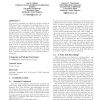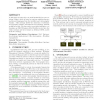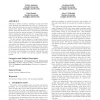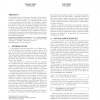WWW
2006
ACM
15 years 6 days ago
2006
ACM
Many systems use past behavior, preferences and environmental factors to attempt to predict user navigation on the Internet. However we believe that many of these models have shor...
WWW
2006
ACM
15 years 6 days ago
2006
ACM
We describe a framework for automatically selecting a summary set of photographs from a large collection of geo-referenced photos. The summary algorithm is based on spatial patter...
WWW
2006
ACM
15 years 6 days ago
2006
ACM
We present a paradigm for uniting the diverse strands of XML-based Web technologies by allowing them to be incorporated within a single document. This overcomes the distinction be...
WWW
2006
ACM
15 years 6 days ago
2006
ACM
In this paper we introduce our multi metamodel process ontology (m3po), which is based on various existing reference models and languages from the workflow and choreography domain...
WWW
2006
ACM
15 years 6 days ago
2006
ACM
Through a variety of means, including a range of browser cache methods and inspecting the color of a visited hyperlink, client-side browser state can be exploited to track users a...
WWW
2006
ACM
15 years 6 days ago
2006
ACM
The web crawler space is often delimited into two general areas: full-web crawling and focused crawling. We present netSifter, a crawler system which integrates features from thes...
WWW
2006
ACM
15 years 6 days ago
2006
ACM
In this paper, we present EgoIR, an approach for retrieving legal information based on ontologies; this approach has been developed with Legal Ontologies to be deployed within the...
WWW
2006
ACM
15 years 6 days ago
2006
ACM
In this paper, we describe SGSDesigner, the ODESGS Environment user interface. ODESGS Environment (the realization of the ODESGS Framework [1]) is an environment for supporting bo...
WWW
2006
ACM
15 years 6 days ago
2006
ACM
Trust is an integral part of the Semantic Web architecture. Most prior work on trust focuses on entity-centered issues such as authentication and reputation and does not take into...
WWW
2006
ACM
15 years 6 days ago
2006
ACM
Locating files based on file system structure, file properties, and maybe even file contents is a core task of the user interface of operating systems. By adapting XPath's po...




